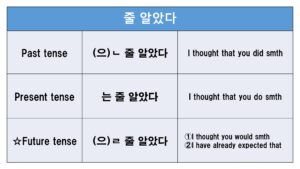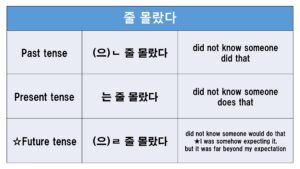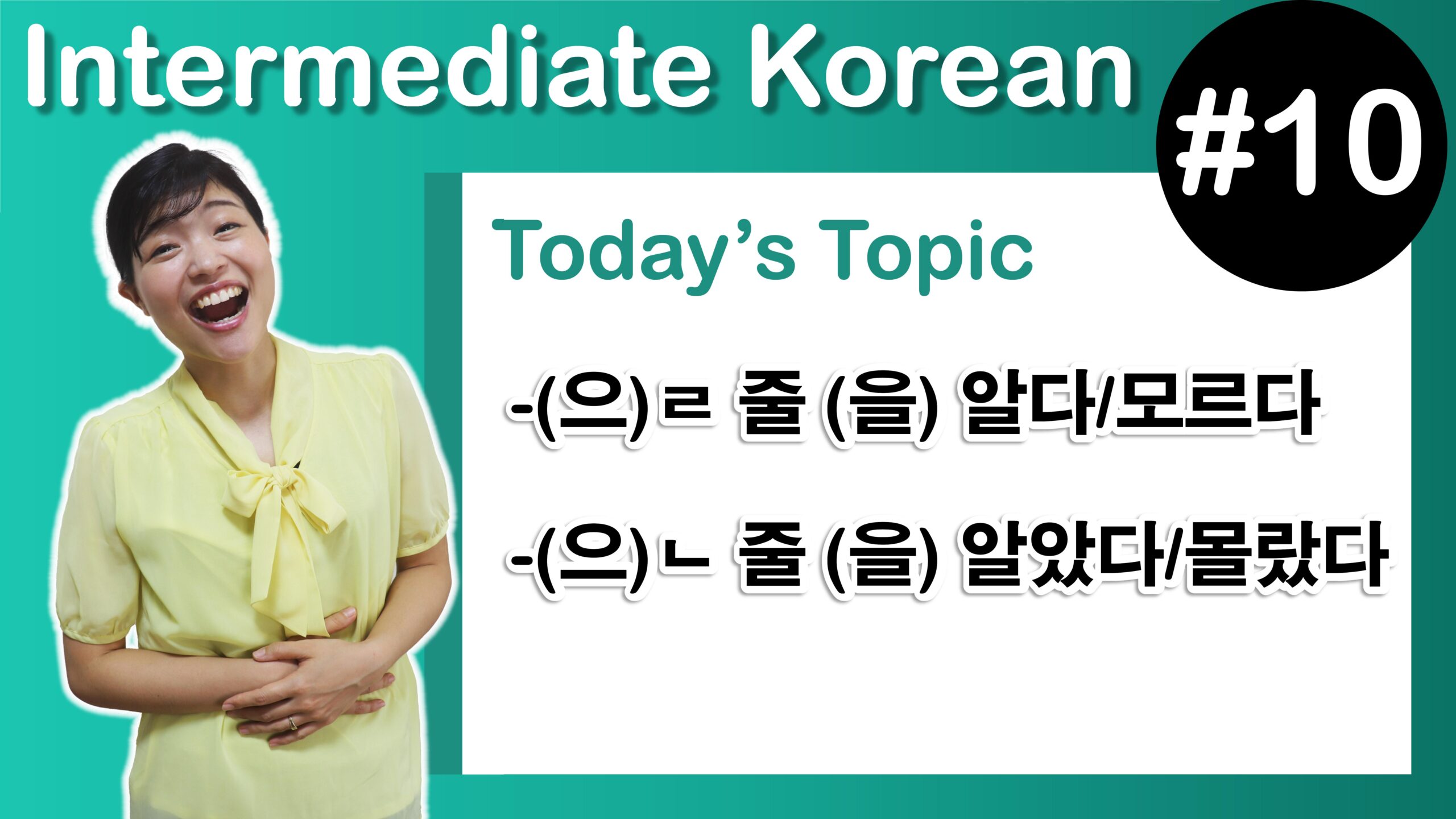안녕하세요! 토미입니다.
Let’s have fun learning Korean today!
I usually explain three grammar rules, but in today’s lesson, I mainly covered two.
①-(으)ㄹ 줄(을) 알다/모르다 “know/ don’t know how to do something”
②-(으)ㄴ 줄 알았다/몰랐다 “I thought that / I didn’t know that”
At first, I was going to cover three grammar rules as usual, but while I was writing the script about -할 줄 알다/모르다, I was even confused, too.
In addition, I thought today’s grammar would be a more complex concept for learners, so I decided to explain it in as much detail as possible.
Also, this is our tenth lesson.
So, I have prepared a special gift for you, which is a small test! The test will cover the sixth to the tenth lessons.
I made quizzes with lots of example sentences you learned in video lessons.
The test format is the same as TOPIK, so you can also use it to prepare for TOPIK.
By taking the small test, I am sure you can get closer to passing TOPIK II and becoming a super master of Korean!
그럼 시작할게요! Then, let’s get started!
–(으)ㄹ 줄(을) 알다/모르다
Verbs(without a final consonant) + ㄹ 줄(을) 알다 / 모르다
Verbs(with a final consonant) + 을 줄(을) 알다 / 모르다
Then, let’s look at the first grammar: –(으)ㄹ 줄(을) 알다/모르다 “know/ don’t know how to do something.”
Do you remember that you can express your ability by using 할 수 있다/없다 “can/cannot”?
Then, what is the difference between 할 수 있다/없다 and 할 줄(을) 알다/모르다?
To see the difference clearly, I will explain with the following examples.
저는 한국어를 할 수 있어요.
I can speak Korean.
Here, “can speak Korean” is an ability, right? So, you can replace it with 할 줄(을) 알다/모르다. So, you can also say,
저는 한국어를 할 줄 알아요.
I know how to speak Korean. I can speak Korean.
Then, what’s different from 할 수 있어요?
Compared to 할 수 있어요, 할 줄 알아요 sounds more like I have already acquired the skill and can use it well!
Therefore, you can give nuance to listeners that your level is over intermediate to the advanced level.”
Crystal clear?
For the application of this grammar, you use it for verbs.
When a verb stem does not have a final consonant, you use -ㄹ 줄(을) 알다/모르다. When it has a final consonant, you use -을 줄(을) 알다/모르다.
Additionally, in the 줄 part, you always pronounce the tense sound as [쭐], so keep it in your mind. It’s not 줄, but [쭐] with more tension.OK?
Now that you know how to use -(으)ㄹ 줄 알다/모르다, let’s look at an example!
Verbs: Example 1
전 한국어는 할 줄 아는데 영어는 할 줄 모릅니다.
I know how to speak Korean, but I don’t know how to speak English.
Here, 하다 is “to do.” But when you use 하다 in languages like 한국어 “Korean” and 영어 “English,” it means “to speak.”
In this sentence, since 하다 does not have a final consonant, you add -ㄹ 줄 알다/모르다 to the verb stem and make the phrase 할 줄 알다 “know how to say,” 할 줄 모르다 “do not know how to say,” got it?
Now, let’s move on to the following example.
Verbs: Example 2
넌 춤출 줄도 몰라?
You do not even know how to dance?
The part of 춤출 줄 sounds challenging to pronounce, doesn’t it?
춤출 줄, 춤출 줄, It is almost like a tongue twister.
Anyway, here, since 춤추다 “to dance” does not have a final consonant, you add -ㄹ 줄 모르다 to make 춤출 줄 모르다 “do not know how to dance.”
In this example, when you add -도 after 줄 and make the phrase -(으)ㄹ 줄도 알다/모르다, it emphasizes the meaning like do/do not even know how to do smth.
As you can see, this example sentence sounds sarcastic.
So, please be careful when you say it to your friends.
Quiz
Then, let’s deepen our understanding with some quizzes. Which one is the correct answer?
1. 토미 씨는 된장찌개 ( )?
Does Tammy know how to cook Doenjang-jjigae?
(1)끓여 봤어요? (2)끓일 줄 알아요?
The correct answer is number two.
When you want to say “to cook (soup),” you can use 만들다.
However, 끓이다 “to boil” sounds more natural in Korean.
Since 끓이다 “to boil” does not have a final consonant, you add -ㄹ 줄 알다 to make 끓일 줄 알다 “know how to boil.” Here, you want to ask, “Does Tammy know how to cook ~?” so you use 요 form and make the phrase 끓일 줄 알아요?
Number one is wrong because 끓여 봤어요? “Have you cooked ~?” is a phrase to ask about one’s experiences.
Okay, then, let’s read it out loud together.
토미 씨는 된장찌개 (끓일 줄 알아요)?
Please read it at least three times. Then, let’s move on to the following quiz.
2. 옛날에는 글자를 ( ) 사람이 많았대요.
I heard long ago that many people did not know how to read letters.
(1)못 읽을 줄 (2)읽을 줄 모르는
The correct answer is number two. 읽다 is “to read,” and since it has a final consonant, you add -을 줄 모르다 to make 읽을 줄 모르다.
After that, you want to say, “~who do not know how to read,” so you use -는, which makes a verb into a noun modifier.
And you make the phrase 읽을 줄 모르는.
Number one is wrong because grammatically, you cannot combine 못 and 줄 알다/모르다, so please keep that in mind.
Then let’s read it together.
옛날에는 글자를 ( 읽을 줄 모르는 ) 사람이 많았대요.
Please practice with it at least three times.
-(으)ㄹ/는 줄 알았다/몰랐다
Verbs + 는 줄 알았다 / 몰랐다
Adjectives(without a final consonant) + ㄴ 줄 알았다 / 몰랐다
Adjectives(with a final consonant) + 은 줄 알았다 / 몰랐다
Nouns + 일 줄 알았다 / 몰랐다
[Past tense]
Verbs(without a final consonant) + ㄴ 줄 알았다 / 몰랐다
Verbs(with a final consonant) + 은 줄 알았다 / 몰랐다
[Future tense]
Verbs(without a final consonant) + ㄹ 줄 알았다 / 몰랐다
Verbs(with a final consonant) + 을 줄 알았다 / 몰랐다
Next grammar, -(으)ㄹ/는 줄 알았다/몰랐다 is the past tense of –(으)ㄹ 줄 알다/모르다.
So, the meaning seems to change into “knew/did not know how to do smth.”
However, it means something completely different, like “I thought that / I didn’t know that.”
This is too tricky!
I think I heard that. Are you guys following me?
Even the meaning of -줄 알았다/몰랐다 slightly changes whether the noun modifier is the present tense or the future tense.
Also, some of you might have noticed that it is pronounced as [쭐] in (으)ㄹ 줄 and 줄 in (으) ㄴ/는 줄.
So, be careful with the pronunciation as well.
Then, please look at this table from 줄 알았다.

You can use -줄 알았다 when you misunderstand something.
It can be expressed with the past, present, and future tenses.
If it is in the past tense, you use -(으)ㄴ 줄 알았다, I thought that you did something.
If it is in the present tense, you use -는 줄 알았다, I thought that you would do something.
The future tense is important because it has two different meanings.
One is, “I thought you would do something,” and the other one is, “I have already expected that,” or “I knew that.”
You can guess which meaning a speaker is trying to use by seeing the context and a facial expression.
Then, let’s look at some examples.
To explain quickly, I will use “he” as the pronoun, even though I don’t know if the speaker is a man or a woman. OK?
The first one is the past tense.
Past Tense Verbs: Example 1
엄마가 청소한 줄 알았다
I thought that my mom had already cleaned.
Even though his mom did not clean, he thought she had ‘already’ cleaned.
The next one is the present tense.
Present Tense Verbs: Example 2
엄마가 청소하는 줄 알았다.
I thought that Mom is cleaning.
In this situation, he thought his mom is cleaning now, but she is not.
The next one is important! The future tense!
Future Tense Verbs: Example 3
엄마가 청소할 줄 알았다.
I thought Mom would clean.
The sentence has a future form so that it can be interpreted in two ways.
The first one would mean that it was misunderstood and unexpected.
So, the speaker expected Mom to clean at that time, but she did not.
The meaning will become clear if the ending is something to express disappointment, like 엄마가 청소할 줄 알았지 “I thought mom would clean” or 엄마가 청소할 줄 알았는데 안 했네. “I thought Mom would clean, but she didn’t.”
The second meaning would be “I have already expected that,” or “I knew it!” so it is 엄마가 청소할 줄 알았어, 역시 우리 엄마야. “I knew that my mom would clean. That’s my mom.”
Can you see the difference between the two?
Then, let’s look at 줄 몰랐다 in the chart as well!

You use 줄 몰랐다 when you realize or get to know something for the first time. Please look through the table from the past tense, the present tense, and the future tense.
First of all, the past tense is -(으)ㄴ 줄 몰랐다, meaning “did not know someone did that.”
The present tense is 는 줄 몰랐다, meaning “did not know someone does that.”
These are easy to understand.
Now, here is an important part coming.
That is the future tense. The future tense is -(으)ㄹ 줄 몰랐다, which means “did not know someone would do that.”
Like the English translation, this speaker is surprised that it happened in the past, not in the future.
It is confusing because it is a future tense that describes the past.
Oh, tricky, tricky. I will explain these concepts with more examples.
Again, I will use the pronoun “he” here to understand it clearly. Then, let’s see an example.
Past Tense Verbs: Example 1
엄마가 청소한 줄 몰랐다.
I did not know that my mom had already cleaned.
This is easy to understand, isn’t it?
It means he realized that his mom had “already” finished cleaning.
The next one is the present tense.
Present Tense Verbs: Example 2
엄마가 청소하는 줄 몰랐다.
I did not know that my mom was cleaning.
This means the speaker did not know that his mom was cleaning now.
I translated it progressively into English, such as “was cleaning.”
But in Korean, it is more like “mom cleans.” OK?
The last one is important, the future tense.
Future Tense Verbs: Example 3
엄마가 청소할 줄 몰랐다.
I did not expect that my mom would clean.
The future tense means, “Mom, you cleaned the room!” It shows that he was surprised that his mom cleaned the room.
Therefore, even though it is the future tense, the speaker was surprised at the fact of the past. Crystal clear? I hope you do.
So far, you have understood examples of verbs.
For your additional note, for adjectives, it becomes -(으)ㄴ 줄 알았다/몰랐다, and for nouns, it becomes -인 줄 알았다/몰랐다.
Then, let’s look at an example
Present Tense Verbs: Example 4
깜짝이야! 난 니가 아직도 자는 줄 알았어.
Oh my gosh! I thought that you were still sleeping.
You can use this phrase when you stealthily eat some cake while your friend sleeps.
Here, 자다 is a verb, so you add -는 줄 알았다 to the verb stem to make 자는 줄 알았다 “I thought that you were sleeping.”
For smooth translation, I use the past progressive tense in English, such as “you were still sleeping,” but in Korean, it means “you still sleep.”
As I said before, Korean people use -줄 알았다/몰랐다 when something unexpected happens, like in this example sentence.
So, they often use this grammar with 깜짝이야! Or 엄마야! which means, “Oh my gosh!.” Do you get it?
Then let’s move on to the following sentence.
Future Tense Verbs: Example 5
난 엄마가 다 해 줄 줄 몰랐지.
I never thought my mom would do all of these things for me.
Here, 해 주다 “do something for” has no final consonant. So, you add -ㄹ 줄 몰랐다 to make 해 줄 줄 몰랐다 “I did not expect that (my mom) would do it for me.”
Also, his mom “did all of the things” on her own, so even though it is the future tense, the speaker is talking about what happened in the past. Crystal Clear?
Let’s look at some examples of sentences with adjectives next.
Adjectives: Example 6
그 사람이 그렇게 똑똑한 줄 몰랐네.
I didn’t know that guy was that smart.
Here, 똑똑하다 “smart” is an adjective without a final consonant, you add ㄴ 줄 몰랐다 to get 똑똑한 줄 몰랐다 “I didn’t think he was smart.”
Finally, let’s look at some example sentences with nouns.
Nouns: Example 7
이 떡볶이가 아주 맵다고 들었는데 이 정도일 줄은 몰랐어요.
I heard that this tteokbokki is very spicy, but I didn’t know it would be this spicy.
이 정도 means “this much,” but it is more than expected in this case, so it is expressed as “up to here.” Since it is a noun, you add 일 줄 몰랐다 to make it 이 정도일 줄 몰랐다 “I didn’t know it would be.”
By adding 은 after 이 정도일 줄, you can emphasize that 이 정도일 줄.
Quiz
Then, let’s deepen your understanding with some quizzes. Which one is the correct answer?
1. 안색이 안 좋아서 어디 ( ).
You look pale, so I thought you were sick.
(1)아픈 줄 몰랐잖아 (2)아픈 줄 알았잖아
The correct answer is number two.
아프다 is “to be sick.” This is an important expression because many learners tend to recognize 아프다 as “to get hurt.”
But it has one more meaning: “to be sick.”
Anyway, 아프다 does not have a final consonant, so you add -ㄴ 줄 알았다 to make 아픈 줄 알았다 “I thought you were sick.”
And then, you want to confirm it like “~, you know?” so you add -잖아 to make 아픈 줄 알았잖아.
The number one is wrong because it means “I did not think that you were sick, you know?” and it got the opposite.
Okay, then let’s read it together.
안색이 안 좋아서 어디 (아픈 줄 알았잖아).
I recommend you read this part several times. Let’s see the next one.
2. 혼자 다 ( ) 모자랄 정도네요.
I thought I could not finish everything alone, but it was almost insufficient.
(1)못 먹을 줄 알았는데 (2)못 먹을 줄 아는데
The correct answer is number one.
못 먹다 is “cannot eat,” and it has a final consonant.
You want to say, “I thought that I could not finish it,” so you add -을 줄 알았다 to make 못 먹을 줄 알았다.
And then, you have to change it into “Even though~,” so you use -는데 to make 못 먹을 줄 알았는데.
Number two is wrong because it uses the present tense 아는데.
This expression of “I thought that / I did not expect that” is always used in the past tense like -(으)ㄴ 줄 알았다/몰랐다.
Okay, then let’s read it out loud together.
혼자 다 (못 먹을 줄 알았는데) 모자랄 정도네요.
Please read this part at least three times!
Homework
Then, I will give you a wonderful present for your homework.
해바라기처럼 밝고 환하게!
Brightly and brilliantly as a sunflower!
Homework, come on!
The first assignment is to write two sentences using the grammar we learned today.
① Please tell me about the ability that you acquired with some effort, using –(으)ㄹ 줄(을) 알다 “know how to do something.” For example, I would make a sentence like
- 저는 한국어 중급 가르칠 줄 알아요.
I know how to teach intermediate Korean.
② Please use -(으)ㄴ 줄 알았다/몰랐다 “I thought that / I didn’t know that” and tell me something you have gotten to know recently and got surprised at.
For example,
- 제가 상 받을 줄 몰랐어요.
I didn’t know I was going to get an award.
I just wanted to make a sentence like a celebrity who won the Academy Awards.
How can you be imaginative when you make your sentences? I am looking forward to reading your homework!
The second homework is to memorize new words.
Please memorize the forty words from number 361 to number 400 on page 5 in the intermediate vocabulary list.
My website has a vocabulary quiz of forty words, so feel free to try it.
The link is in the description box.
Also, as I mentioned at the beginning of this video, I have prepared a test that you will love to take.
The test will cover lessons 6 to 10.
The test format is the same as TOPIK, so you can use it to prepare for TOPIK.
That’s it for today. You guys did a great job! High five!!
Today, we learned about these expressions, but how was it?
Were you following me? Yes?
역시 여러분! 똑똑하시네요! 잘 하실 줄 알았어요!
I knew it! You guys are so smart! I thought you would do it!
그럼 오늘도 행복 가득, 웃음 가득한 하루 되세요! 한국어 화이팅, 화이팅, 화이팅!!



